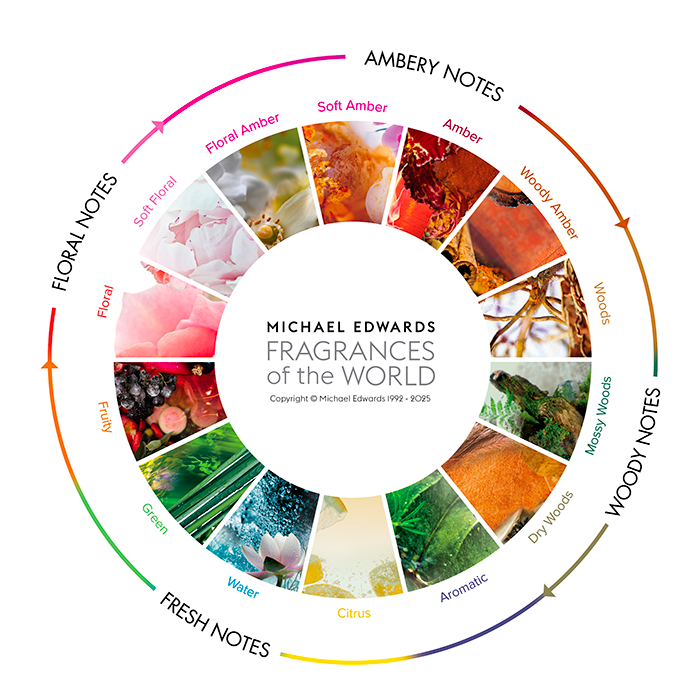
What are Fragrances Families?
Share
Olfactive families
Olfactory families are groups in which perfumes can be broadly classified based on the most prominent note in its olfactory pyramid. The grouping of perfumes can never be completely objective or definitive. Many fragrances contain aspects of different families. Even a perfume designated as "single flower" will have subtle undertones of other aromatics. There are hardly any true unitary-scent perfumes consisting of a single aromatic material. The family classification is a starting point to describe a perfume but does not fully characterize it.
Classification by Sugandhco:
Traditionally only a very few families existed due to the constraints of the small Platte of available ingredients. In the early 1900’s we categorized fragrances into Floral, Spicy, Animalic and Woody. Since 1945, new categories have emerged to describe modern scents, due to great advances in the technology of compound design and synthesis, as well as the natural development of styles and tastes:1. Citrus: The development of newer fragrance compounds has allowed for the creation of more tenacious citrus fragrances.Citrus scents are crisp and clean, usually characterized by notes like lemon, grapefruit, orange, and bergamot. They're refreshing, like a Chilled Lemonade on a hot summer day. Example: Azeemah, Lamhe
2. Floral: Combining Single Floral & Floral Bouquet traditional categories. This family is composed of a large variety of creations ranging from sumptuous bouquet arrangements to “soli flora’ compositions. These Floral Blends are often enriched with green, aldehydic, fruity or spicy hints. With its natural scent, the floral note is one of the most widely used in women’s perfumes. Example: Jaadu, Noor
3. Woody: Fragrances dominated by woody scents, typically agarwood, sandalwood, cedarwood, and vetiver. Patchouli, with its camphoraceous smell, is commonly found in these perfumes.Woody scents are characterized by smelling like the great outdoor. This family is recommended for people who enjoy hiking, camping, and various other outdoor activities. Example: Madhosh, Sanket
4. Oriental:Oriental compositions draw their richness and sophistication from precious substances such as amber, resin, tobacco, spices, exotic woods, and animal notes. Also known as “amber” fragrances – they stand out because of their unique blend of warmth and sensuality. This large class features sweet, slightly animalic scents of ambergris or labdanum, often combined with vanilla, tonka bean, flowers, and woods. Can be enhanced by camphorous oils and incense resins, evoking Victorian era "Oriental" imagery. Example: Yaquet, Nafaasat, Musk Amber
5. Aromatic: Aromatic family is mainly composed of sage, rosemary, thyme, and lavender usually complemented with citrus and spicy notes. These compositions’ manly character makes them an all-time favorite in men’s perfumery. Example: Armaan, Tilism, Phuhaar
6. Fruity/Gourmand: Scents with "edible" or "dessert-like" qualities, often containing vanilla, tonka bean, and coumarin, as well as synthetic components designed to resemble food flavors. Features fruits other than citruses, such as peach, plum, watermelon, dew fruit, passion fruit, and others. Example: Ulfat, Naira
7. Spicy: Warm, sensual notes of cardamom, incense, nutmeg, cinnamon, clove and pepper form the spicy family of fragrances. Basically, this is the perfume one would wear if they wanted to feel mysterious. Usually, a soft woody or oriental fragrance is warmed up by these bold spicy notes giving it a distinct note and enhances the originality and character of these perfumes. Example: Mehboob, Musk Amber, Madhosh
8. Aquatic:The compositions of this family brighten up the basic aromatic accord with an ocean note. Aquatic perfumes, as the name suggests, are characterized by marine notes like algae, salt, and fresh sea air. This is a rather newer category, first appearing in our 2006 Sugandhco Fida. A clean smell reminiscent of the ocean, leading to many androgynous perfumes. Generally contains calone, a synthetic discovered in 1966, or more recent synthetics. Example: Kausar, Fida
Fragrance wheel
This newer classification method is widely used in retail and the fragrance industry, created in 1983 by the perfume consultant Michael Edwards. The new scheme simplifies classification and naming, as well as showing the relationships among the classes. The four main families are Floral, Oriental, Woody and Fresh. Each of these are divided into subgroups and arranged around a wheel.


5 comments
Good job!
nawabi boobs and pussy fragrance when?
Great!
very informative!
I love the floral one.. Specially Jaadu